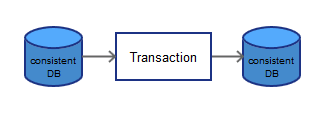Consistency
For databases, ‘‘consistency’’ means satisfying integrity constraints, which are about the correctness of the data in a database. So a database is ‘‘consistent’’ if all its constraint are satisfied.
Integrity Constraints
Some of the integrity constraints are:
- entity integrity constraint (a primary key cannot be null)
- referential integrity constraint (if a tuple $X$ in one relation refers to some other tuple $Y$ in another relation, $Y$ must always exist in that relation)
Examples of predicates that must hold:
- $x$ is a key of relation $R$
- Functional Dependency $x \to y$ holds in $R$
- domain($x$) = {Red, Green, Blue} - the only allowed values
- no employee should make more than twice average salary (achieved with triggers in Active Databases)
In a database to specify if data is valid we use constraints.
Transaction Constraints
Transaction Consistency
- essentially involve two database states: the old state (before $T$) and the new state (after $T$)
- but ‘'’always’’’ maintaining a database in a consistent state is impossible
Example:
- we have $n$ accounts in a bank: $a_1, …, a_n$
- suppose that we store the total sum somewhere in the database
- constraint: $a_1 + … + a_n = \text{TOTAL}$
- but during a transaction the database may be in inconsistent state
- transaction: deposit 100 USD to $a_2$
- to do that we need:
- update $a_2: a_2 \leftarrow a_2 + 100$
- (at this moment the constraint is not satisfied)
- update TOTAL: $\text{TOTAL} \leftarrow \text{TOTAL} + 100$
- so during the transaction we’ll have a state in which the DB is not consistent
We can define a ‘‘transaction’’ as a sequence of updates on the database.
- It ‘‘preserves consistency’’ if executing it brings a database from one consistent state to another.
- The database doesn’t have to be consistent during the transaction.
- For transactions, consistency is the letter “C” in the ACID.

- And a transaction should happen in Isolation (Letter “I” in ACID)
Crash Recovery
But what if during the execution of a transaction a crash occurs?
- if we take no action the database will be left in an inconsistent state
- main techniques: Database Transaction Logs
Consistency Models
For Distributed Databases maintaining consistency is harder. Consistency models determine rules for ‘‘visibility’’ and ‘‘order’’ of updates.
Strict Consistency
- every replica sees every update in the same order
- all reads return the most up-to-date data no matter what replica is asked
- need to employ some techniques for commit propagation, for example, Two-Phase Commit
- according to the CAP Theorem, cannot achieve strict consistency at the same time with partition-tolerance
Eventual Consistency
- order in which updates received is important
- as $t \to \infty$ all readers will see the writes
- but updates are not atomic as in case of Strict Consistency
Weak Consistency
- every replica will see updates
- but there’s no guarantee on the order
in this case later updates may be overwritten by earlier ones because they arrived later
Sources
- Database Systems Architecture (ULB)
- Design Patterns for Distributed Nonrelational Databases
- Consistency and availability in Amazon’s Dynamo
See also
- BASE - weaker alternative to ACID
- the CAP Theorem